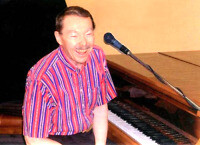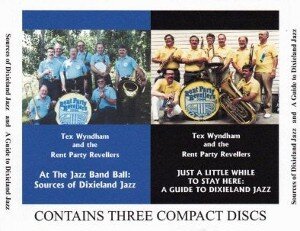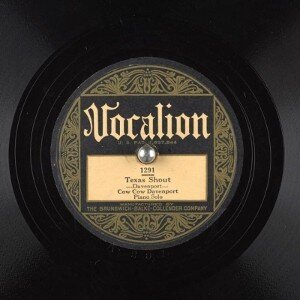 Set forth below is the fifty-ninth “Texas Shout” column. The second installment of a three-part essay, it first appeared in the March 1995 issue of The West Coast Rag, now known as The Syncopated Times. The text has not been updated. Read Part 1 or Part 3
Set forth below is the fifty-ninth “Texas Shout” column. The second installment of a three-part essay, it first appeared in the March 1995 issue of The West Coast Rag, now known as The Syncopated Times. The text has not been updated. Read Part 1 or Part 3
The Visual Method was not my first exposure to music lessons. For unimaginable reasons, when I was in the third grade, my father bought a mandolin from a colleague at his office with the notion that I might like to play it. Perhaps he thought I might become a gondolier someday.
I took a few lessons, but I had about as much interest in the mandolin back then as I do now. Thus, that experiment was rather short-lived.
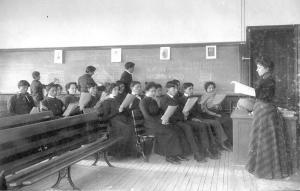 It did have an unforeseeable payoff, however, because it gave me some familiarity with the mechanics of stringed instruments. When I became interested in Dixieland, I taught myself to strum a ukulele that I found around the house. Eventually, in the mid-sixties, I wound up playing rhythm banjo for a Drexel Hill, PA-based Dixieland band, The Good Time Six.
It did have an unforeseeable payoff, however, because it gave me some familiarity with the mechanics of stringed instruments. When I became interested in Dixieland, I taught myself to strum a ukulele that I found around the house. Eventually, in the mid-sixties, I wound up playing rhythm banjo for a Drexel Hill, PA-based Dixieland band, The Good Time Six.
I found my way to cornet by a similarly circuitous route. When I was in the seventh grade, my parents decided that I should learn the trombone, so I was taken to the junior high school band director with that thought in mind. However, my arm was not yet long enough to reach the seventh position, so I was handed instead a baritone horn, a valve instrument that plays in the same range as the trombone.
The literature for baritone exerted the same compelling attraction for me as had the literature for the mandolin four years previously. Exit one baritone horn.
Segue to midway in the eleventh grade, when I had become very much interested in music. I decided that I wanted to play in a group with other musicians, so I went to the office of our high school band director and had a conversation along the following lines:
“I would like to play in the band.”
“What instrument do you play?”
“Piano.”
“We don’t have a piano in our marching band.”
“I know. However if there is an instrument you need played, and you’ll show me how to play it, I’ll give it a try.”
“Have you ever had lessons on any other instrument?”
“A few years ago, I had some on baritone horn.”
Enter the baritone horn again. I commenced weekly lessons and held down the second baritone horn chair in the Pierre S. du Pont High School Band until the end of the year, at which time a wonderful thing happened. The entire trombone section graduated.
Mr. Beymer handed me a trombone before summer recess along with an instruction book, informing me that, upon the commencement of school in the fall, I would occupy the exalted first trombone chair.
I was ecstatic, especially as I was now able to play a Dixieland instrument along with my Firehouse Five Plus Two 78s, of which I had a complete set. I quickly matched the slide positions to the baritone’s valve fingering and, each day, played along with every single FH5 side.
My turntable was mounted on a combination 78 rpm player and reel-to-reel tape recorder, so it was hardly a precision instrument. Moreover, I have no mechanical ability at all, being the sort of person who is defeated by a thumbtack.
(My wife won’t even let me hang a picture at home. Were I to attempt the task, it would soon become a Laurel & Hardy plot – within a half-hour, the basement would be flooded, the ceiling would be on fire, and the garage would be reduced to splinters.)
As I toiled along with the FH5, I couldn’t help but notice that they functioned in what seemed to me to be rather unusual keys. Nearly all the tunes were in B natural, F sharp or E natural.
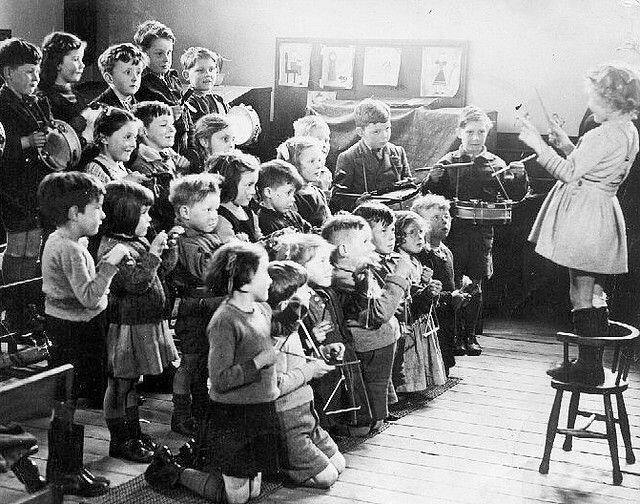 Oh well, I thought, mine is not to reason why, especially if this is the way I’m going to master this exciting music. As you have guessed by now, my minuscule mechanical skill fell far short of clueing me into the fact that the turntable on my record player was revolving somewhat faster than 78 rpm.
Oh well, I thought, mine is not to reason why, especially if this is the way I’m going to master this exciting music. As you have guessed by now, my minuscule mechanical skill fell far short of clueing me into the fact that the turntable on my record player was revolving somewhat faster than 78 rpm.
However, for a while after that time, I could play tunes more comfortably in those impossible keys than in the most common Dixieland keys of B flat, F natural and E flat. I can still play brass instruments without much trouble in B, F# and E as a result of that experience, so I suppose I gained something from it.[*]
During my last year at college, I picked up an old rotary-valve tuba for $20 (and made $25 playing it that same night). It was an E♭ tuba, but I never bothered to re-learn the fingering. Instead, I pretended it was a baritone horn and transposed the chords, just as I had done with the piano – that is, if we were playing a tune in Bb, I’d assume it was in F and improvise a tuba part accordingly. I still play E♭ tuba that way, though I haven’t been on any tuba gigs in years.
Swarthmore College had a small music department, all 100% classical. My thirst for knowledge about music was so great that, as electives, I took a year of classical music theory and a year of classical music composition. Neither taught me much that was of value in Dixieland or ragtime, but I do have one special memory from each course.
One day the theory teacher was late, and I was whiling away the time by noodling some blues on the classroom baby grand. When he entered, the professor passed behind the piano bench and whispered in a friendly but firm way that, in the future, the department’s piano was not to be subjected to that kind of music.
As an assignment in my composition class, I wrote a short piece for a classical string quartet. I didn’t retain a copy, as it was just ordinary homework to me.
A few weeks later, at an all-college assembly sponsored by the music department, I was quite surprised to hear Professor Swan announce that the next number would be a string quartet composed by Tex Wyndham. It was both amusing and satisfying to see the amazed expressions on the faces of students around me as they realized that the leader of the campus Dixieland band was involved in such highbrow activities.
By the time I reached graduate school, I was a fairly competent tubaist and tailgate trombonist. During the 1962-63 school year, I worked six nights a week at Your Father’s Mustache in Boston, playing solo piano upstairs two nights, playing trombone with and leading a Dixieland band two nights, and playing a variety of instruments behind the three-banjo sing-a-long combo two nights.
One afternoon, my first wife came rushing back to our Ellery Street apartment to tell me that a cornet was in the window of a thrift store two blocks away. Once again, the price was $20.
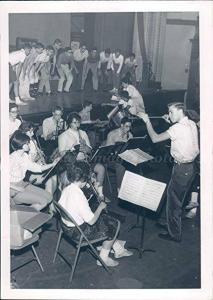 My previous experience with a lead horn was on a battered trumpet a friend gave me in high school. It had been in some sort of accident that had broken the tailpipe and bell loose. They had been soldered back on the leadpipe side of the horn, so it had a rather strange look to it, and it leaked badly, but it did play, and I fooled around with it some. (It now hangs over the door to my music room.)
My previous experience with a lead horn was on a battered trumpet a friend gave me in high school. It had been in some sort of accident that had broken the tailpipe and bell loose. They had been soldered back on the leadpipe side of the horn, so it had a rather strange look to it, and it leaked badly, but it did play, and I fooled around with it some. (It now hangs over the door to my music room.)
However, cornet was what all the vintage-period Dixieland bands used, and I was taken with the idea of owning one. My band’s trumpet player, whom I used as a consultant, informed me that, if all the valves and slides worked I could hardly go wrong for $20. Thus, I added the cornet (which was an old department store house brand model, but in excellent shape) to my arsenal of instruments with the banjo band.
Once again, I never bothered to re-learn the fingering to conform to parts written for B♭ trumpet/cornet (the standard size horn). In trumpet music, if you want a B♭ trumpet to sound a “B♭,” you write a “C” on his score. Not for me, though.
I associate the fingering with the notes that come out of the horn. Thus, I can sight-read melodies on the cornet from piano-vocal song sheets or concert-pitch lead sheets, but can’t play a written cornet part without painstakingly going over it in advance.
I only had to play a couple of cornet tunes a night at Your Father’s Mustache, so I had no particular need to develop much technical facility. However, a few months later, I graduated and returned to my home town of Wilmington, Delaware to begin my career in DuPont’s finance function.
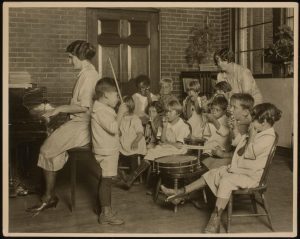 I also started gathering musicians weekly to my home to jam some Dixieland tunes. After a year, people started offering us gigs, and The Red Lion Jazz Band was born, first taking the field at a DuPont Treasury Division office party in July of 1964.
I also started gathering musicians weekly to my home to jam some Dixieland tunes. After a year, people started offering us gigs, and The Red Lion Jazz Band was born, first taking the field at a DuPont Treasury Division office party in July of 1964.
I played trombone and piano on the initial two Red Lion gigs. It soon became obvious though, given the limited number of Dixielanders available in Wilmington, that I would have to play melody if I wanted a band that could handle the type of repertoire I had in mind. I couldn’t be dependent on the scene to provide me with a reliable supply of lead men who knew the West Coast revivalist tunes.
Thus, essentially out of self-defense, I took up cornet in earnest. Despite steady practicing, I never seemed to be developing much range or endurance. I probably should have sought lessons, but having figured so much out for myself up to that time, I decided to try some home-grown therapy.
Looking in the mirror, I concluded that I didn’t have very much lip covering my two front teeth. It appeared that I had more room over on the left side of my mouth.
Well, I thought, Wild Bill Davison plays on the side of his mouth, and he’s one of my favorite musicians. If it’s good enough for him, it’s good enough for me. So, I moved the mouthpiece over to the left and, once I got used to it, the new position seemed to be a better one. It’s been there ever since.
In fact, I remember the night a fan brought a high school trumpet teacher to see The Red Lion Jazz Band at our regular monthly gig at the Hotel Du Pont’s Green Room. I was told that the first thing the guest said upon observing me in action was “That guy has the worst embouchure I’ve ever seen.”
* [Since the foregoing was written, I did have one occasion to employ this seemingly useless ability. The Rent Party Revellers played a festival at which the Grand Finale was to consist of each band playing, along with a tune of its choice, one or two choruses of “When My Dream Boat Comes Home” played in a key to be pulled out of a hat that contained slips, each of which was marked with one of the twelve keys.
I found out later that this was actually designed as a gag so that the audience could get some laughs watching the musicians fumble around in oddball keys. I also learned that, as far as we were concerned, the fix was in – the Revellers were to be assigned B natural, considered by the folks who designed this plan to be the most difficult key.
Well, the harmony for “Dream Boat” doesn’t amount to much – it stays on the tonic chord most of the way. If the cornetist can get through the transposed melody in decent shape, a band made up of even halfway competent Dixielanders should be able to sneak by.
As it happened, drawing on my decades-old experience with that malfunctioning 78 player, I was able to nail the melody in B natural on the first chorus and even improvise a satisfactory hot lead line for the second chorus. The upshot was that, though history will not rank it among the all-time great “Dream Boats,” the Revellers unwittingly undercut the joke by doing a respectable job. Amazing how the past rears its head at the most unexpected times.]
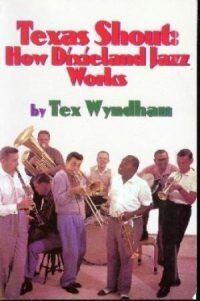 Want to read ahead? Buy the book!
Want to read ahead? Buy the book!
The full run of “Texas Shout” has been collected into a lavishly illustrated trade paperback entitled Texas Shout: How Dixieland Jazz Works. This book is available @ $20.00 plus $2.95 shipping from Tex Wyndham, On request, Tex will autograph the book and add a personalized note (be sure to tell him to whom the note should be addressed).
Tex Wyndham’s 3 CD Guide to Dixieland with music and commentary is available for $20 plus $2.95 shipping. The separate CD, A History of Ragtime: Tex Wyndham Live At Santa Rosa, is available for $13.00 plus $2.00 shipping. On request, Tex will autograph the inner sleeve and add a personalized note (be sure to tell him to whom the note should be addressed).
Send payment to Tex Wyndham, P.O. Box 831, Mendenhall, PA 19357, Phone (610) 388-6330.
Note: All links, pictures, videos or graphics accompanying the Shouts were added at the discretion of the Syncopated Times editorial staff. They did not accompany the original columns and do not necessarily reflect the opinion of Tex Wyndham.
From roughly 1970-2010, Tex Wyndham was: (1) one of the best-known revivalist Dixieland jazz musicians in the US, as cornetist, pianist and bandleader, (2) one of the best-known ragtime pianists in the US, and (3) one of the most respected critics in the US of Dixieland jazz, ragtime, and related music. He is the only person about whom all three of those statements can be made.

